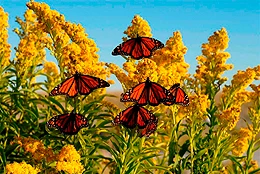|
 Garden centers have long advocated purchasing “the right plant for the right place.” The native plant movement wants to push this strategy to a higher level by familiarizing customers with plants indigenous to the local area. Garden centers have long advocated purchasing “the right plant for the right place.” The native plant movement wants to push this strategy to a higher level by familiarizing customers with plants indigenous to the local area.
But that’s exactly where the issue gets a bit muddled. How do you define “local” and determine which plants fit the bill? And how do cultivars of natives (sometimes dubbed “nativars”) fit into the equation?
Native resident?
It’s a tricky question, said Steve Castorani, owner of North Creek Nurseries in Landenburg, Pa. Castorani is one of the forces behind the American Beauties Native Plants program, which supports the National Wildlife Federation (NWF).
“We define a plant’s native range by using maps provided by the USDA on their Natural Resource Conservation Service website,” Castorani said. “This is a helpful tool that was developed over time using information provided by state botanists [with the Department of Natural Resources]. We also refer to the National Wildlife Federation for further definition.”
Another way to determine native range, Castorani said, is to research where plants historically grow in their wild state, often described as “pre-Columbian distribution.”
Castorani and Jerry Brown of Fisher Farms in Oregon recently used all these tools—and more—to pinpoint native selections for Oregon and Washington state. Fisher Farms has joined the American Beauties program, and plans to offer native plants for their immediate area and eventually a broad swath of the Pacific Northwest.
The team worked closely with NWF in Seattle to round up plant candidates. Castorani said field research also helped get the program off the ground.
“I actually went out into the market,” he said, “to see which [native] plants were offered at retail. I talked to small growers out there. There was a lot to learn. There’s a vast difference between various microclimates in the region.”
A home for natives
The homework has been done, and plants are in production. The next task is for retailers to promote and sell natives in their garden center.
With the current demand for hardy, drought-tolerant offerings, native plants should certainly end up on gardeners’ wish lists.
“People in this area are really willing to add natives into their home gardens,” said Brown of Fisher Farms. “They’re looking to create a natural biodiversity. It seems the consumer is open and knowledgeable about native plants.”
According to Brown, American Beauties’ association with the National Wildlife Federation also helps spur interest in natives. Customers enjoy helping a good cause, since a portion of sales go to NWF. And they feel connected to something “bigger.” They’ve gone beyond mere gardening—they’re creating a wildlife habitat. This mentality, coupled with continued interest in edible plants, is appealing to the next generation of gardeners.
“I think these are just natural doorways to bring the 20- and 30-year-olds into gardening,” Brown said.

|


 Garden centers have long advocated purchasing “the right plant for the right place.” The native plant movement wants to push this strategy to a higher level by familiarizing customers with plants indigenous to the local area.
Garden centers have long advocated purchasing “the right plant for the right place.” The native plant movement wants to push this strategy to a higher level by familiarizing customers with plants indigenous to the local area.





